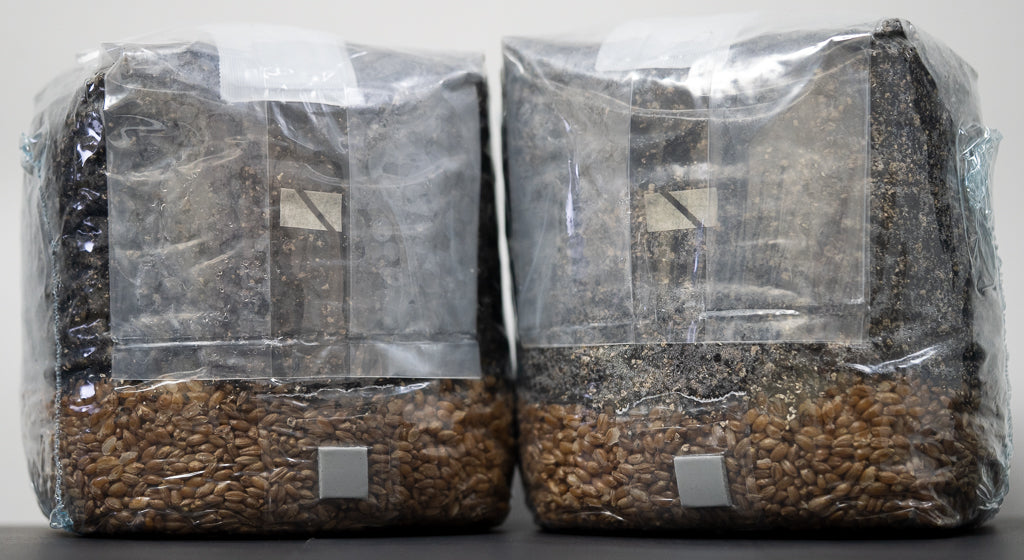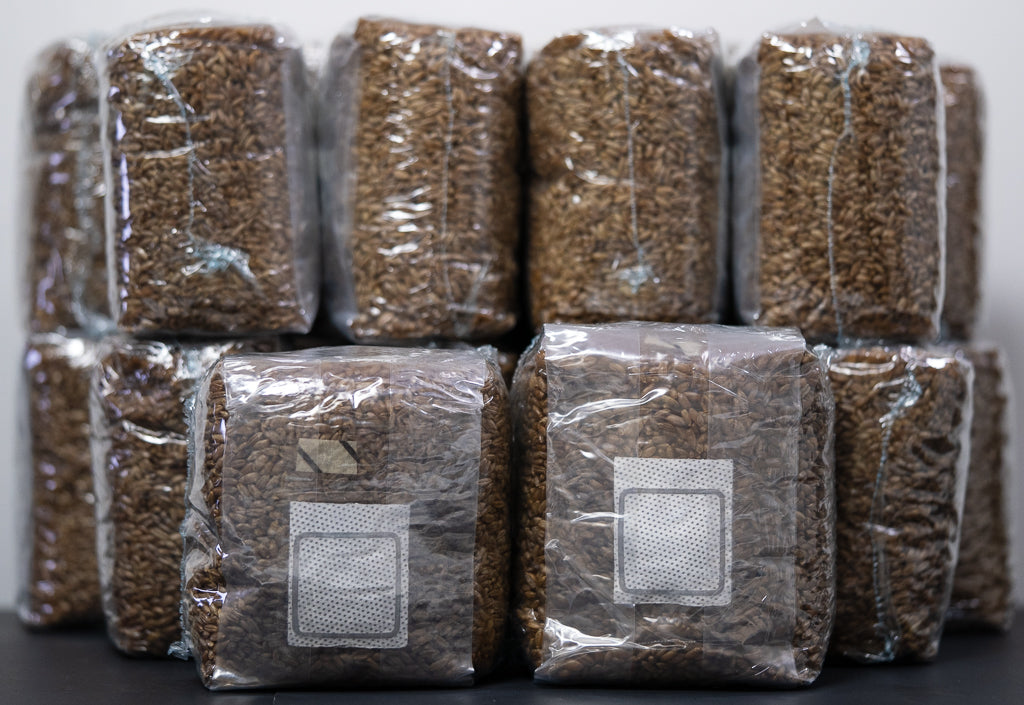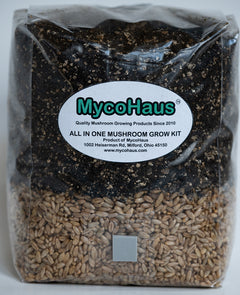Liquid Culture Instructions
How to use your live liquid culture syringe.
Thank you for purchasing MycoHaus liquid cultures. These simple step by step instructions will guide you through the inoculation process and give you tips for cultivation. Enjoy!
To properly incubate your mycelium it must remain at a constant temperature between 70 and 90 degrees depending on what species you are growing.
This temperature is also ideal for countless number of other molds and bacteria.
In mycology, all growers will experience contamination of one kind or another, it is almost inevitable.
Even experienced growers, in laboratories will encounter an occasional contamination, but if you practice sterile technique, it will greatly reduce your chances of a contamination occurring, ensuring bountiful yield for years to come.
Sterile technique...not just “clean”:
Some of the procedures you do at home require sterile technique. The purpose of ensuring sterile technique is to prevent infection.
The word sterile means, “free from germs.” It is up to you as the mycologist to ensure your work area is as clean and as disinfected as it possibly can be.
If you take the proper steps you can greatly reduce the chance of contamination to your product, ultimately producing far larger yields.
Rules for sterile technique:
Always wash your hands before and after doing any sterile procedure. Short fingernails are important.
Practice good oral hygiene. Brush teeth, floss and use mouthwash.
Wear clean and freshly laundered clothes, scrubs or a lab coat if possible.
Wear rubber gloves, Tyvek wrist sieves, a face mask, hair net, goggles, and even shoe covers when possible.
Sterile supplies must be kept dry. If the outer wrapper is not sealed, the kit is not sterile.
Prepare a work area by washing the counter or table with a disinfectant spray, bleach or soap and water. Make sure the surface is dry before you put your sterile supplies down.
The use of a HEPA (high efficiency particulate air) filter, air purifier or laminar flow hood can reduce up to 99.997% of airborne particulates and microbes.
Special care must be taken when you handle supplies to keep them sterile.
Touch only the outside wrapper; only touch the sterile supplies with clean gloved hands.
Do not sneeze or cough on the supplies or in the area in which you will be working.
Try not to reach over the sterile supplies when doing the procedure. It may be best to have your work surface off to your side.
Now, with all of that being said, we can proceed to inoculate your substrate.
How to inoculate and cultivate your substrate:
All work should be done in front of a laminar flow hood or glove box in the cleanest environment possible. Following sterile technique will greatly reduce the chance of contamination.
Your package should contain: live liquid culture syringe and sterile packaged needle.
You will need: alcohol wipes, rubber gloves, face mask and instructions.
Make sure your hands are clean, and you are wearing clean, freshly laundered clothes
Clean your work area thoroughly with a disinfectant such as bleach or Lysol.
Wipe down your work surface, your substrate and syringe with rubbing alcohol and spray an air sanitizing spray like Oust or Nutra-air.
Leave your work area for a few minutes to let the disinfectant settle.
Put on your gloves and wipe them with rubbing alcohol.
Carefully open the packaging that your liquid culture syringe came in, remove the cap on the end of the syringe and attach the needle.
Make sure you shake the liquid culture syringe to disperse the mycelium.
Wipe the injection point on your substrate with alcohol.
Remove the cap from the needle, and insert it through the injection point of the substrate. You will only need to use 1-2 ml of your 10 ml syringe.
Larger substrates will require more solution. It is best to wipe the needle tip with alcohol or flame sterilize it between each injection.
Place tape over the injection port if necessary, and if using myco bag substrates, you can shake them to disperse the mycelium, but excess shaking can damage mycelium.
If there is any solution left over, place the needle cap back on the syringe, place back in bag and store in a refrigerator for future use.
Place your bag in an incubator or storage bag in a dark, clean place like a clean box inside a closet.
Mycelium will incubate anywhere from 70-86 degrees Fahrenheit depending on the specific strain.
Allow the bag to fully colonize (turn completely white). This should take 10-14 days at warmer temperatures, or 16-21 days at temperatures around 70 degrees.
Please research the specific species of mushroom you are cultivating in order to incubate at correct temperature.
Once fully colonized and consolidated there are many ways to get your grain spawn to fruit into actual mushrooms.
Some mushrooms will fruit right in the jar or bag with no additional help, others have to be mixed with a bulk substrate like compost, straw, mulch or wood chips.
Some require a casing layer or protective barrier like casing or vermiculite.
Once again it is important to research the specific species you are cultivating because different mushroom prefer different growing mediums and climates.
Grain transfer from colonized grain spawn to sterilized compost or bulk substrate:
This next section will guide you through the process of taking your colonized spawn bag and adding it to a bulk substrate such as compost or hardwood mulch.
While doing a grain transfer it is important to perform the procedure in and adhere to the same sterile conditions and techniques as described in the previous section.
Once your work area, tools, substrates and self are clean carefully, open the bag of compost by cutting slightly below the line where the bag was sealed.
Gently break up the compost and mix the contents of the bag around.
Break up your bag or jar of grain spawn and add it to the bag of compost.
Without removing too much air, seal the bag of compost with an impulse sealer.
Masking or packing tape works well in the absence of a sealer. You can also simply fold the top and hold it shut with paperclips. Mix the compost and grain spawn thoroughly to create and even mixture that is well aerated.
Remember mushrooms and mycelium need oxygen to grow.
Incubate the compost at the proper temperature depending on what species you are cultivating.
Storing the bags in complete darkness and in the cleanest environment possible will ensure healthy growth.
Fruiting mycelium directly in spawn bags:
There are numerous types of fruiting techniques. The Internet is full of instructions of different methods. It is up to you to find out the best way that will work for you.
One simple and easy way to fruit your mycelium is to do it directly in the bags.
Mushrooms need a cooler temperature to fruit, so if you incubated your bags at a warmer temperature, like 80-90 degrees put the bags in an environment from 65- 76 degrees.
The bag will also need to be in a place where it will receive a few hours of indirect sunlight each day.
If the inside of the bag appears to be too dry you can cut the top off the bag and using a spray bottle spay a small amount of distilled, or spring water in the bag. It is best to spray the walls of the bag and not the mycelium itself.
Be careful not to spray too much water as it can harm the mycelium as well as promote mold growth. You can fold the bag shut, and hold it shut with a paper clip.
Stand the bag upright to let it breath, and to give the mushroom fruit bodies room to grow.
You should see water droplets forming on the inside of the bag. Placing a hydrometer inside the bag for the first few days to make sure you have the humidity right can be a good idea.
You must keep the humidity above 85%, but the closer to 100% the better.
After 14-16 days you should start to see the beginning of fruit bodies growing.
They will usually appear as small “pins” depending on what kind of species you are growing.
When the mushrooms are fully-grown, pick them by cutting them at the base with a small paring knife.
You do not want to pull the mushrooms off of the cake because you will damage the mycelium network and future fruit bodies may not grow.
More mushrooms should continue to grow in the bag for the next couple of weeks before the substrate is spent.
Building a Simple Fruiting Chamber:
At this point in the growing process, it is necessary to change two factors in the growing environment: humidity and temperature.
For the last few weeks, the mycelium has been incubating at 86 degrees.
The correct temperature for mushroom fruiting is between 70 and 76 degrees. The humidity level needs to be as close to 100% as possible.
There are dozens of plans available on the Internet on how to build a fruiting chamber, and this is one of the simplest ways.
Pour the perlite in the plastic tote, and spread it out evenly. You want a 2-3 inch layer at the bottom. Fill with approximately one half, to one gallon of water.
Mix the water and perlite until it has the consistently of oatmeal. You do not want the water level to rise above the perlite.
It also helps to add a few tablespoons of rubbing alcohol or peroxide to help keep the water sterile.
Place the hydrometer in the terrarium. It should take about 24 hours for the tank to reach 95% humidity.
If needed use a spray bottle to add moisture to the fruiting chamber, but do not spray the substrate directly with water.
When you are ready to place the trays into the fruiting chamber, remove their lids so they can get plenty of air.
Mushrooms require light for different reasons than plants. They only require 4 to 6 hours of indirect light per day.
If the plastic tote is not placed in an area that will receive indirect light, use a low wattage light, placing it adjacent to the fruiting chamber, as a lighting source.
Once again, ensure that the fruiting chamber will be placed in an area that will be between 70 and 76 degrees, which should be normal room temperature.
It is best to disturb the fruiting chamber or remove the lid as little as possible, but the cakes do need fresh air to produce fruit bodies, so if desired, once a day, or every other day you can remove the lid and fan the cakes to help excess carbon dioxide build up.
At this point in the growing process the mushroom mycelium should be pretty well established, and not that vulnerable to contaminates, but mold can and will grow in the terrarium if not well maintained.
After 14 to 16 days, you should notice the beginnings of fruit bodies growing. Depending on what species you are growing, a mushroom can grow from a small pin to a full mushroom in as little as 48 hours from this point.
Once your trays are full of mushrooms, pick them by gently twisting them at the base. You want to be careful not to destroy the roots.
This will be your first “flush.” Leave the aluminum trays in the fruiting chamber because more fruit bodies will continue to grow in the next few days. Each tray should flush 2 to 4 times before the mycelium is “spent.”
Thank you for choosing MycoHaus & please check out our online stores for more cultivation equipment and mushroom cultures.
Copyright © MycoHaus, 2014, All rights reserved. No unauthorized duplication or distribution of this publication without permission.



